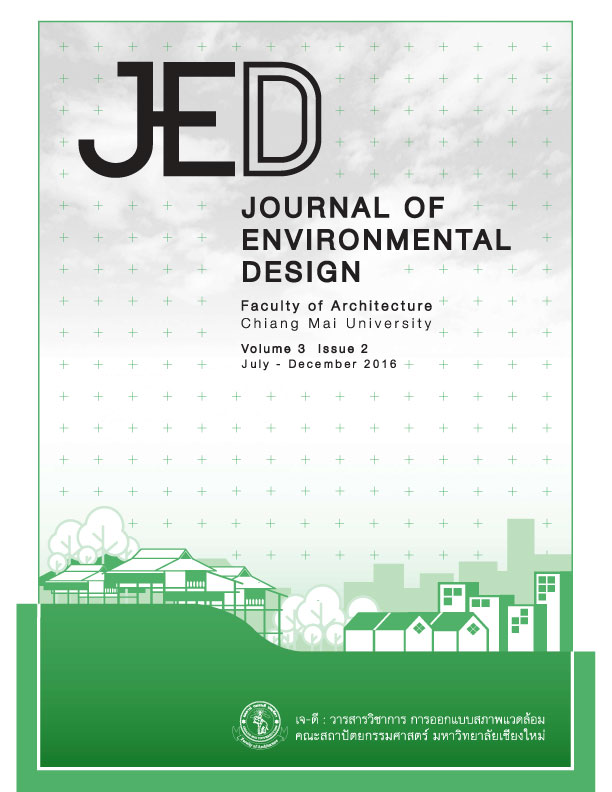การสร้างการตระหนักรู้ในด้านประวัติศาสตร์พื้นที่แก่คนใน ชุมชนย่านหนองระบู ตำบลเวียง อำเภอเมือง พะเยา (Building up historical awareness for communities in Nhong Rabu, Tambon Wieng, Amphur Muang, Phayao)
Main Article Content
บทคัดย่อ
การศึกษาด้านประวัติศาสตร์พื้นที่ย่านหนองระบู ตำบลเวียง อำเภอเมือง พะเยาสามารถแบ่ง ช่วงเวลาตามเหตุการณ์สำคัญเป็น 6 ยุคสมัย ได้แก่ 1) ยุคก่อตั้งเมืองภูกามยาวหรือพยาว (พ.ศ. 1639-1877) 2) ยุคเจ้าสี่หมื่นปกครองเมืองพะเยา-อาณาจักรล้านนา (พ.ศ. 1877-2101) 3) ยุคประเทศราชล้านนา-อาณาจักรพม่าหงสาวดี (พ.ศ. 2101-2317) 4) ยุคฟื้นฟูเมืองพะเยา-เจ้าหลวงเมืองพะเยา-อาณาจักรสยามรัตนโกสินทร์ (พ.ศ. 2386-2445) 5) ยุคสยามปฏิรูปการปกครองล้านนา (พ.ศ. 2445-2457) และ 6) ยุคหลังเจ้าหลวงเมืองพะเยาองค์สุดท้าย-ปัจจุบัน (พ.ศ. 2457-2559) ซึ่งในการศึกษาในเชิงลึกจากตัวอย่างอาคาร 27 หลัง จาก 10 กลุ่มประเภทรูปแบบทางสถาปัตยกรรม พบว่ารูปแบบทางสถาปัตยกรรมของอาคารที่ปรากฏภายในย่านสามารถอธิบายประวัติศาสตร์พื้นที่ของย่านได้เก่าแก่ที่สุดในยุคฟื้นฟูเมืองพะเยา และรูปแบบอาคารที่ถูกประเมินจากผู้ให้สัมภาษณ์ว่ามีคุณค่าด้านประวัติศาสตร์และสามารถเป็นตัวแทนรูปแบบสถาปัตยกรรมที่เป็นเอกลักษณ์ของย่านได้แก่ อาคารประเภทเรือนร้านค้าสองชั้นหลังคาทรงปั้นหยาหรือมนิลา อาคารประเภทเรือนร้านค้าสองชั้นก่อนยุค Modern และอาคารประเภทโรงสีข้าว และพบว่าคนในชุมชนที่อยู่ในช่วงอายุ 61-70 ปีมีศักยภาพมากที่สุดในการบอกเล่าเรื่องราวทางประวัติศาสตร์แก่คนในชุมชน แนวทางในการสร้างการตระหนักรู้ในด้านประวัติศาสตร์พื้นที่แก่คนในชุมชนย่านหนองระบูเน้นไปที่การมองเห็นซึ่ง เป็นกระบวนการขั้นแรกของการตระหนักรู้ โดยใช้เครื่องมือ 3 ส่วนประกอบกัน ได้แก่ แผนที่แสดงขอบเขตย่าน ตำแหน่งของอาคารที่มีรูปแบบทางสถาปัตยกรรมแต่ละประเภท ภาพถ่ายในอดีตที่พิมพ์ให้มีขนาดใหญ่ติดตั้งบนระนาบของอาคาร และสื่อวีดีทัศน์บอกเล่าประวัติศาสตร์พื้นที่ซึ่งอธิบายยุคสมัยทางประวัติศาสตร์ของพื้นที่ โดยมีกลไกหลักในการสร้างการตระหนักรู้ในด้านประวัติศาสตร์พื้นที่แก่คนในชุมชน คือ ผู้สูงอายุในชุมชนซึ่งมีประสบการณ์ร่วมกับเรื่องราวประวัติศาสตร์ของย่าน และเป็นการสร้างปฎิสัมพันธ์ระหว่าง คนต่างวัยในชุมชนและคนในชุมชนกับนักท่องเที่ยวผู้มาเยือน
The historical study of Nong Ra Boo District area, Wiang, Meuang Phayao can be separated by important situations in 6 periods : 1) Meuang Phukhamyao establishing period (A.D.1096-1334), 2) Lanna period (A.D.1334-1558), 3) Hongsawati period (A.D. 1558-1774), 4) Rattanakosin period (A.D.1843-1902), 5) period (A.D. 1902-1914) and 6) After the last Chao Luang Meuang Phayao period (A.D. 1914-2016). First finding from in depth investigating in 27 sample of building from 10 groups of architectural characteristic is characteristic of architecture which appear in Nong Ra Boo district area can describe history of Nong Ra Boo district between Rattanakosin period and After the last Chao Luang Meuang Phayao period only. Historical value characteristics of architecture which were evaluated by interviewees are 2 stories shophouse which has hip or gable hip roof 2 stories shophouse, before modern architecture period shophouse and rice mill, three of these can be identity of architecture in Nong Ra Boo District as well. Moreover, second finding is 61 – 70 years old people can clarify history of Nong ra Boo District effectively. Guideline of historical recognition creating for Nong Ra Boo community members focus on human visibility which is first process of cognition. Three tools of historical recognition creating guideline included of district area and architectural characteristics location map, old photos printed in a large scale which were installed on the plane of the building and video which explains the history of district. Significant mechanism of historical recognition creating for Nong Ra Boo people is elders which have experience with the history of district. Also, it creates interaction between people of different ages in the community and people in the community and visitors.


